|
 Become
a fan on Facebook
Become
a fan on Facebook  Follow
on Twitter Follow
on Twitter
Article by Mark Dujsik | December 26,
2016
Here
are the ten best films of 2016:
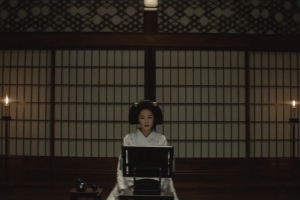 10.
The
Handmaiden 10.
The
Handmaiden
This
invigorating exercise in shifting perspectives and sympathies tells the story of
con artists in Japanese-occupied Korea during the 1930s. These are characters
who attempt to lie, cheat, and steal their way into the heart of another person,
only to discover that they have cheated—or have been cheated—themselves. It
would be unfair to disclose the exact number of con artists in The Handmaiden. Part of the enjoyment of co-writer/director Chan-wook
Park's film is discovering the extent of deception happening in front of us and
behind the scenes. What can be revealed without giving away too much is that
Park and Seo-kyung Chung's screenplay (based on Sarah Water's novel Fingersmith)
is divided into three parts. Each part reveals a new layer deception, as well as
an assortment of moral and emotional contradictions. It's a sensual film, not
only in terms of its frankness about sex but also in its gorgeous aesthetic
qualities. The film's central concern is with the motives behind the overlapping
cons, allowing us to see these characters as the paradoxical entities that they
are—capable of both giving pleasure and inflicting pain. In this film, those
two states are interchangeable. It all depends on one's perspective.
 9.
Tower 9.
Tower
Everything
one would expect from a film about a historical event is present in Tower: talking heads, archival photographs, news reports, and
dramatic recreations to fill in the narrative gaps. Even so director Keith
Maitland's film is a daring
piece of documentary filmmaking. The recreations have actors play the people
involved in the 1966 murders at the University of Texas, where a man killed 14
people (including the unborn child of an 8-months-pregnant woman) and wounded 32
others while holding a position on the observation deck of the tower in the
university's main building for over 90 minutes. Those actors are then animated
through rotoscoping. The effect is intentionally unnatural. It is distancing but
never distracting. That distancing effect is clearly intentional, too. We are
witnessing something that we could never truly understand what it's like to
experience. It also challenges the notion that violence like this, which happens
with more frequency now, is seen as normal. The narrative jumps between the
accounts of the survivors, as we hear and see harrowing stories of pain and
courage. The film's power is in its clear-eyed documentation of what happened
that day, and it's also in the deliberate juxtaposition of cinematic form and
reality.
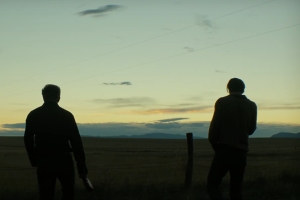 8.
Hell or High Water 8.
Hell or High Water
The
combination of desperate men and desperate times leads to an inevitable result
in Hell or High Water, a
cops-and-robbers drama that makes room for sympathy for both sides. This is a
film about life-and-death situations, a race against time, and the effects of
the financial crisis on ordinary folks. It's also a film, though, that will put
all of these concerns on hold in order to portray the mood and tenor of this
place—West Texas—and the people within it. Billboards announce "debt
relief" and other promises of returning to financial normalcy. A waitress
at a local diner has a particular way of taking orders, while a man at another
diner waxes philosophical about the absurdity of robbing banks in this day and
age. The robbers are brothers Toby (Chris Pine) and Tanner Howard (Ben Foster).
The cops are Texas Rangers Marcus Hamilton and Alberto Parker (Gil Birmingham).
Screenwriter Taylor Sheridan gives us a sense that the parties could have a
pleasant conversation over a steak dinner under different circumstances, while
director David Mackenzie establishes an inescapable backdrop of small-town
poverty, based on a broken a system and shattered promises. This is a simple but
perceptive, morally ambiguous, and detailed piece of storytelling.
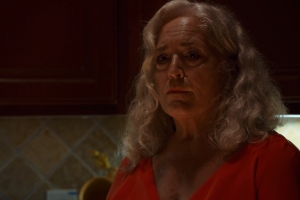 7.
Krisha 7.
Krisha
Nobody
sets out to become the villain, and no one sees himself or herself in the role
of the villain in one's own story. Krisha (a tremendous Krisha Fairchild), the
eponymous central figure of writer/director Trey Edward Shults' debut feature
film, is about as close to fulfilling the role as a person can when at a family
Thanksgiving dinner. The character was an addict, who has been away from her
family to get healthy. Now, she has returned into the fold, and Krisha follows the increasingly uncomfortable events from her
perspective. Shults' camera simply, expertly moves with Krisha as she attempts
to maneuver her way into a sense of normalcy with her family again. It's a
dizzying experience, as the character's paranoia about the family's thoughts
about her become our own suspicions about them and Krisha. There's a connection
between the film's fiction and the reality of Shults' life (various family
members play the family members in the film), which might explain why all of the
film's elements are so deeply felt and clearly communicated. We can understand
the family's trepidation about having Krisha around, and but we're invested in
and sympathetic toward Krisha's gradual realization that she is both the
destructive antagonist the wounded protagonist in her own story.
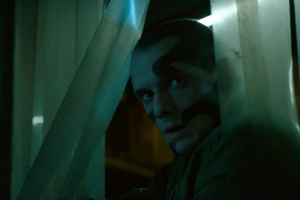 6.
Green Room 6.
Green Room
Here
is a ferocious, relentless thriller. Jeremy Saulnier's Green
Room gives us characters who are capable of mistakes and puts them into
circumstances in which one mistake can have lethal consequences. The plot is
simple: A struggling punk rock band takes a gig at a neo-Nazi club in the middle
of nowhere, because they are in desperate need of money. Pat (the late Anton
Yelchin) comes across the scene of a murder in the club's green room, leading
the band to be imprisoned in said room. What unfolds is more or less a battle of
wits between the quick-witted prisoners who have limited resources to employ,
and their captors, who possess seemingly unlimited resources but are cautious to
use them immediately. That's because Darcy (an icy Patrick Stewart), the gang's
leader, wants to stage the witness' murders as accidents. With this film,
Saulnier shows himself to be in the process of becoming one of our more
effective and considerate filmmakers when it comes to violence. There are always
repercussions to the story's brutally violent acts, so while, on the surface, the
film is a crackling potboiler with a fatalistic sense of forward momentum,
it also deals with the inconsistent beliefs of the senselessness of violence and
the at-times necessity for it.
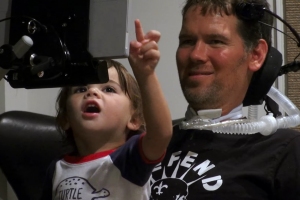 5.
Gleason 5.
Gleason
Former professional football player
Steve Gleason was diagnosed with Amyotrophic lateral sclerosis (ALS),
otherwise known as Lou Gehrig's disease. The effects of the disease are
terrifying: As it progresses, voluntary motor functions shut down, inhibiting
and eventually stopping one's ability to move and speak. Gleason is an example
of how multiple layers of courage can exist in one individual, and the mere
existence Gleason, a documentary from
director Clay Tweel about Gleason's life with ALS, reveals a significant layer.
Through a series of video journals and footage of Gleason's home life, Tweel
assembles a portrait of a man—a husband, a father, a son, a celebrity, a
philanthropist—that does not intentionally hide or inadvertently obfuscate a
single detail of Gleason's life. That includes the effects of the disease.
Shortly after his diagnosis, Gleason learns that his wife Michel is pregnant, so
he records video diaries as a way to pass on lessons to his son. The journals
are where the film is at its most intimate. Gleason doesn't hold back on
expressing his doubts and fears. He wants his son to know him—all of him. This
includes him breaking down in tears after he watches some of his old entries,
realizing that he sounds "ill." The film doesn't sugarcoat any of
this. There's nothing noble about illness, but there is nobility in how some
people approach the reality of it.
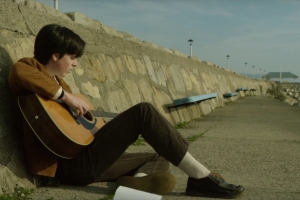 4.
Sing Street 4.
Sing Street
Sing
Street may only be about "this kid, a girl, and the
future," but that's just a simple way of saying it's about everything that
matters. Writer/director John Carney's equally delightful and insightful
film delves into the constant pangs and limitless possibilities of adolescence.
The setting is Dublin in 1985. Ireland is in the midst of an economic crisis.
These are the trying times in which the 15-year-old Connor (Ferdia Walsh-Peelo)
finds himself, as his parents, in order to save money, send him to a local
Catholic school filled with strict rules and rough bullies. Connor's only escape
is music—namely the new wave bands of the decade. The girl is Raphina (Lucy
Boynton). He decides to start a band in order to impress her. Carney starts with
nostalgia for this place and time, but he doesn't stop there. The film allows
its characters to live and breathe as far more than just representations of a
lovingly recalled time. Carney's affection and empathy for these characters
seems to have no limit, as Connor slowly realizes that there is much more to the
people he knows—himself included—than what he sees on the surface. As for
the film's music, the original songs accurately ape the style of the era and are
especially catchy. Like the characters, the music evolves, and Carney
effortlessly uses it as a way to communicate what's happening in these
characters' lives.
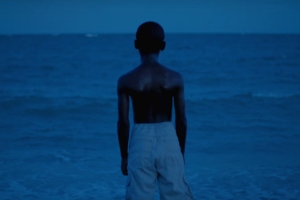 3.
Moonlight 3.
Moonlight
Moonlight is
a coming-of-age story about one person within the context of three, specific
stages of his life: as a boy, a teenager, and a man. Writer/director Barry
Jenkins' film is uncommonly attuned to the way that experiences shape everything
about a person. Through three tremendous performances—one for each of the
stages of the man's life—that somehow coalesce into a singular whole, we can
spot the obvious differences and the subtle similarities in this individual as
his life progresses. The character's name is Chiron. As a boy, he is called
Little (Alex Hibbert). As a teenager (played by Ashton Sanders), he has
reclaimed his birth name. As a man, he calls himself Black (Trevante Rhodes),
after a nickname someone else gave him as a teenager. This is a story of
definitive moments and influences that only become so in retrospect. Some of
these influences include his mother (played by Naomie Harris), who is only as
present in his life as a drug addict can be, and Juan (Mahershala Ali, whose
performance makes such an impact that the character's presence remains even
after he is absent from the story), a drug dealer who imparts crucial lessons
and an even more influential example. The film is filled with a sense of
constant discovery—of the character learning about himself and the world, of
us witnessing that character's evolution in unexpected and delicate ways, of
seeing the emergence of Jenkins' uniquely bold and boldly confident voice as a
filmmaker.
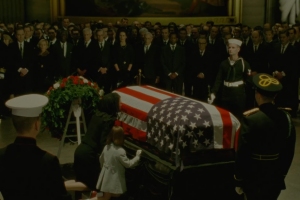 2.
Jackie 2.
Jackie
President
Kennedy has died. Mrs. Kennedy remains. It's a simple question at the heart of Jackie:
Now that her husband is dead, who is Jackie Kennedy? The Jackie of director
Pablo Larraín's film, played with courageous emotional honesty by Natalie
Portman, certainly doesn't know. Even in death, her husband and his influence
still hold a tight grip on this woman. Noah Oppenheim's screenplay is not a
biography of the former First Lady. It's a character piece that takes three
moments in Jackie Kennedy's life and plays them against each other. The first is
an interview with an unnamed journalist (Billy Crudup) about a week after the
President's funeral. The second is a filmed tour of the White House in 1962,
after the completion of an extensive restoration of the residence overseen by
the First Lady. The third is the three-day period between Kennedy's
assassination and his funeral.
That
section of the story is the film's central one. It is about Jackie's shock,
grief, and uncertainty, as well as her determination to ensure that her
husband's funeral is the one she believes the man deserves. The
conversation around Kennedy has turned from policy to legacy. The film is wise
in the way it sees Jackie as a constructor of narratives, building her husband's
legacy despite the knowledge that his presidential accomplishments are slim, and
it's tragic in its recognition that those narratives have little to do with her. She
has become a symbol of grief. Portman's performance and
the film as
a whole chip away at the shell of that icon of decorum and pity, presenting us
with a more comprehensive understanding of her grief, strength, and
foresight.
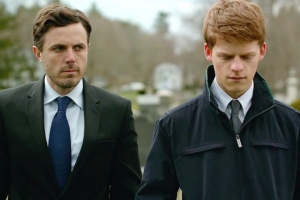 1.
Manchester by the Sea 1.
Manchester by the Sea
Writer/director
Kenneth Lonergan's exceptional Manchester by the Sea, the best film of 2016, isn't just about grieving.
It's also about how we avoid grieving—or at least try to avoid it. Lee
Chandler (Casey Affleck, revealing a meticulous understanding of how fear can
look like stubbornness, anger, and apathy) has lost his brother. He wants to
avoid this pain, because this death raises the terrible memory of the worst pain
of his life. Patrick (Lucas Hedges, in a performance so understated and
with such a seemingly unflappable sense of confidence that the character's
displays grief are all the more potent) has lost his father. He wants to avoid
this reality, because, as a teenager, he's not supposed to be experiencing this
at this point in his life. Lee's brother (played by Kyle Chandler) has made him
Patrick's guardian. Lee does not want the responsibility.
Lonergan's
screenplay is more or less a series of such vignettes, tied together by Lee and
Patrick's respective reactions to Joe's death, as well as the ebbs and flows of
their new life together under one roof. It also gradually reveals Lee's life
before the events of the present-day story, with a seamless structure that
intercuts the characters' current trials with an unthinkable tragedy from the
past (Michelle Williams plays Lee's ex-wife, and her performance within only a
handful of scenes is heartbreaking). What Lonergan focuses on is the strange
sense of socially prescribe routine that accompanies the grieving process—the
hospital, the funeral arrangements, the visitations and services and receptions.
The empathy displayed by the film—for these characters' struggles with
new pain and old heartbreak—is abundant and seemingly endless. Lonergan's film
is a marvel of compassion and character-specific observation.
Special
Mention:
 Only
Yesterday Only
Yesterday
Twenty-five
years is a long time for a film from a studio as prestigious as Studio Ghibli to
finally receive a theatrical release in the United States, but such was the case
with Only Yesterday. Isao Takahata's animated film is a lovely examination of
the difficulties of childhood and the struggles of adulthood, as seen through
the eyes and memories of a woman who is still figuring out her life. The lessons
she learned from childhood and the realities of her life as an adult don't
exactly match, but they rarely do. That's the protagonist's predicament, as the
film's story shifts between two times in her life. Takahata differentiates the
two visually, with brighter scenes of the past that play out against incomplete
backdrops and naturalistic present-day scenes that are boldly colored. The
memories are of fairly ordinary concerns—young romance, puberty, and familial
dynamics—while the woman in the present attempts to piece together some
meaning from them. The film positions all of these events, not as answers or
explanations, but as a reminder that the process of growing up doesn't end with
the end of childhood.
Honorable Mention:
Arrival,
Cameraperson, The
Conjuring 2, Embrace
of the Serpent, Fences, The Invitation,
La La Land, Land
and Shade, Little Men,
Lo and Behold: Reveries of the
Connected World, Louder
Than Bombs, Neighbors 2:
Sorority Rising, Silence, Southside
with You, Weiner, Zootopia
Copyright © 2016 by Mark Dujsik. All
rights reserved.
 Back
to Home Back
to Home
|
Buy Related Products

|
